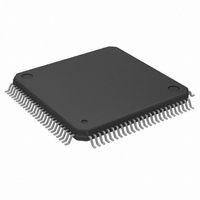M306N4FGTFP Renesas Electronics America, M306N4FGTFP Datasheet - Page 127

M306N4FGTFP
Manufacturer Part Number
M306N4FGTFP
Description
IC M16C MCU FLASH 100QFP
Manufacturer
Renesas Electronics America
Series
M16C™ M16C/6Nr
Datasheets
1.M30622SAFPU5.pdf
(308 pages)
2.M306N4FGGPU3.pdf
(94 pages)
3.M306N4FGGPU3.pdf
(414 pages)
Specifications of M306N4FGTFP
Core Processor
M16C/60
Core Size
16-Bit
Speed
20MHz
Connectivity
CAN, I²C, IEBus, SIO, UART/USART
Peripherals
DMA, WDT
Number Of I /o
85
Program Memory Size
256KB (256K x 8)
Program Memory Type
FLASH
Ram Size
10K x 8
Voltage - Supply (vcc/vdd)
4.2 V ~ 5.5 V
Data Converters
A/D 26x10b; D/A 2x8b
Oscillator Type
Internal
Operating Temperature
-40°C ~ 85°C
Package / Case
100-QFP
Lead Free Status / RoHS Status
Contains lead / RoHS non-compliant
Eeprom Size
-
Available stocks
Company
Part Number
Manufacturer
Quantity
Price
Company:
Part Number:
M306N4FGTFP
Manufacturer:
TI
Quantity:
3 001
Company:
Part Number:
M306N4FGTFP
Manufacturer:
RENESAS
Quantity:
36
Company:
Part Number:
M306N4FGTFP
Manufacturer:
Renesas Electronics America
Quantity:
10 000
Part Number:
M306N4FGTFP
Manufacturer:
RENESAS/瑞萨
Quantity:
20 000
Company:
Part Number:
M306N4FGTFP#UKJ
Manufacturer:
Renesas Electronics America
Quantity:
10 000
Part Number:
M306N4FGTFP#UKJ
Manufacturer:
RENESAS/瑞萨
Quantity:
20 000
- Current page: 127 of 414
- Download datasheet (3Mb)
M16C/6N Group (M16C/6N4)
Rev.2.40
REJ09B0009-0240
12.3 DMA Enable
12.4 DMA Request
Table 12.4 Timing at which DMAS Bit Changes State
i = 0, 1
Software trigger
Peripheral function
When a data transfer starts after setting the DMAE bit in the DMiCON register (i = 0, 1) to 1 (enabled), the
DMAC operates as follows:
(1) Reload the forward address pointer with the SARi register value when the DSD bit in the DMiCON register
(2) Reload the DMAi transfer counter with the DMAi transfer counter reload register value.
If the DMAE bit is set to 1 again while it remains set, the DMAC performs the above operation.
However, if a DMA request may occur simultaneously when the DMAE bit is being written, follow the steps
below.
If the DMAi is not in an initial state, the above steps should be repeated.
The DMAC can generate a DMA request as triggered by the request source that is selected with bits DMS,
and DSEL3 to DSEL0 in the DMiSL register (i = 0, 1) on either channel.
Table 12.4 lists the Timing at which DMAS Bit Changes State.
Whenever a DMA request is generated, the DMAS bit is set to 1 (DMA requested) regardless of whether or
not the DMAE bit is set. If the DMAE bit was set to 1 (enabled) when this occurred, the DMAS bit is set to
0 (DMA not requested) immediately before a data transfer starts. This bit cannot be set to 1 in a program (it
can only be set to 0).
The DMAS bit may be set to 1 when the DMS bit or bits DSEL3 to DSEL0 change state. Therefore, always
be sure to set the DMAS bit to 0 after changing the DMS bit or bits DSEL3 to DSEL0.
Because if the DMAE bit is 1, a data transfer starts immediately after a DMA request is generated, the
DMAS bit in almost all cases is 0 when read in a program. Read the DMAE bit to determine whether the
DMAC is enabled.
Step 1: Write 1 to the DMAE bit and DMAS bit in the DMiCON register simultaneously.
Step 2: Make sure that the DMAi is in an initial state as described above (1) and (2) in a program.
is 1 (forward) or the DARi register value when the DAD bit in the DMiCON register is 1 (forward).
DMA Source
Apr 14, 2006
page 103 of 376
When the DSR bit in the DMiSL register • Immediately before a data transfer starts
is set to 1
When the interrupt control register for
the peripheral function that is selected
by bits DSEL3 to DSEL0, and DMS in
the DMiSL register has its IR bit set to 1.
Timing at which the bit is set to 1
DMAS Bit in DMiCON Register
• When set by writing 0 in a program
Timing at which the bit is set to 0
12. DMAC
Related parts for M306N4FGTFP
Image
Part Number
Description
Manufacturer
Datasheet
Request
R

Part Number:
Description:
KIT STARTER FOR M16C/29
Manufacturer:
Renesas Electronics America
Datasheet:

Part Number:
Description:
KIT STARTER FOR R8C/2D
Manufacturer:
Renesas Electronics America
Datasheet:

Part Number:
Description:
R0K33062P STARTER KIT
Manufacturer:
Renesas Electronics America
Datasheet:

Part Number:
Description:
KIT STARTER FOR R8C/23 E8A
Manufacturer:
Renesas Electronics America
Datasheet:

Part Number:
Description:
KIT STARTER FOR R8C/25
Manufacturer:
Renesas Electronics America
Datasheet:

Part Number:
Description:
KIT STARTER H8S2456 SHARPE DSPLY
Manufacturer:
Renesas Electronics America
Datasheet:

Part Number:
Description:
KIT STARTER FOR R8C38C
Manufacturer:
Renesas Electronics America
Datasheet:

Part Number:
Description:
KIT STARTER FOR R8C35C
Manufacturer:
Renesas Electronics America
Datasheet:

Part Number:
Description:
KIT STARTER FOR R8CL3AC+LCD APPS
Manufacturer:
Renesas Electronics America
Datasheet:

Part Number:
Description:
KIT STARTER FOR RX610
Manufacturer:
Renesas Electronics America
Datasheet:

Part Number:
Description:
KIT STARTER FOR R32C/118
Manufacturer:
Renesas Electronics America
Datasheet:

Part Number:
Description:
KIT DEV RSK-R8C/26-29
Manufacturer:
Renesas Electronics America
Datasheet:

Part Number:
Description:
KIT STARTER FOR SH7124
Manufacturer:
Renesas Electronics America
Datasheet:

Part Number:
Description:
KIT STARTER FOR H8SX/1622
Manufacturer:
Renesas Electronics America
Datasheet:

Part Number:
Description:
KIT DEV FOR SH7203
Manufacturer:
Renesas Electronics America
Datasheet:











